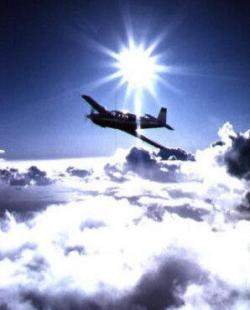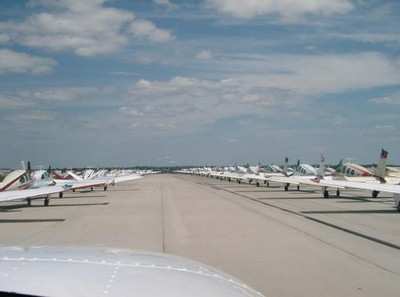Is It Time To Overhaul (Or Even Eliminate) FAA Certification of
GA?
By John Ylinen, Private Pilot
 If you are reading this column in
Aero-News; then you are probably an aviation enthusiast -- and
most likely a pilot. If you became a pilot since the 1970s; you
have been witnessing the slow death of General Aviation. For the
purposes of this editorial; I will confine my discussion to Private
aviation, small plane and privately owned. Not corporate jets or
other such commercial endeavors. Commonly called/flown under Part
91.
If you are reading this column in
Aero-News; then you are probably an aviation enthusiast -- and
most likely a pilot. If you became a pilot since the 1970s; you
have been witnessing the slow death of General Aviation. For the
purposes of this editorial; I will confine my discussion to Private
aviation, small plane and privately owned. Not corporate jets or
other such commercial endeavors. Commonly called/flown under Part
91.
I recently read an editorial in Flying Magazine by Editor in
Chief Robert Goyer titled "Why Certification Matters." In it he
expounds that we are all better off because the FAA certifies our
planes under Part 23. He said that we needed the government to
closely oversee the design, building, and maintenance of our Part
23 aircraft throughout their life. If they didn't; his point was
that we would be letting our aircraft become unsafe and not sure
(of) what we were buying or flying. This editorial got me thinking,
along with my deep concern that we might not be able to fly for
much longer, if the current trend in GA continues. After much
thought; I strongly disagree with Mr. Goyer.
Therefore; this editorial is meant to evoke thought and
discussion for all that want GA to grow and be what it was always
meant to be. Throughout this editorial; I will draw comparisons to
other private transportation modes, mostly automobiles.
Why do we have one that is highly regulated and the other only
lightly regulated?
First let's run through some background for our discussion.
Piston engine aircraft -- new sales -- have been declining for
years. This year GAMA is reporting that only 634 piston aircraft
were sold worldwide. If that trend continues; there cannot be a
viable ecosystem for us to use. There has not been a NEW piston
airframe certified by the FAA since the Cirrus SR20 and Diamond
DA-42 in 1999. That is over a decade ago. The cost
of new aircraft has significantly exceeded inflation since 1970 and
grown exponentially in the last 30 years.
Aircraft manufacturers and parts suppliers, when asked why aren't
they designing new products, cite their number one reason
as the cost to get them "Certified." Some have said it would cost
upwards of $150 to $200 Million to do the FAA part (for a new
aircraft design). This is over and above their own
design and engineering costs. All of us have to pay for that effort
as the chart above clearly shows. When you ask a manufacturer why
they have not improved their product; they cite the time and cost
for FAA certification. Many say there is no way to predict how the
FAA will review their product and when they will complete their
"Certification". This introduces unknowns and uncertainty to the
process. In addition to the acquisition cost; there is the
operations and maintenance cost of owning a Part 23 aircraft.
Annual inspections and having to use "Certified" parts being two
that drive up cost significantly. The next being fuel cost since
the specialized fuel is not used/made in large economic(al)
quantities.

What do we get for this unique government oversight of our
Private mode of transportation? One that does not exist for
automobiles or boats. This oversight has not been always around. It
started in 1934. The Part 23 oversight has been reviewed a few
times by the FAA. The last review was conducted in 2008/2009 and
before that, in 1984.

You can read the full report
here.
This comprehensive study had participants from the associations
that represent us; AOPA and EAA. They were chartered to do a
complete review of the process and could offer any recommendations
or changes that they felt were necessary to support General
Aviation for the next 20 years. From my review of their report;
none of their recommendations will address the pain that the FAA is
causing and which the report and chart above (from their own
report) highlighted. The recommendations were about reclassifying
the way the aircraft and rules apply, but not the rules and costly
process themselves.
So why do we have this massive government oversight and what is
it BUYING for us? The first reason I have heard is that it is
because planes cross state borders and we don't want 50 states
trying to regulate aircraft. Ok, but so do cars and boats. The
biggest one I have seen, is that we must have this government
regulation because we must protect the public and citizens. Ok, if
that were true then we should have massively more oversight and
regulations for automobiles. There were 30,797 fatal accidents in
2009 in Automobiles, killing 33,808 persons of which 4,872 were
non-occupants or innocent by-standers. There were 2,217,000
injuries. The economic cost of traffic crashes was reported as
$230.6 Billon. The 2009 NALL report from AOPA lists 1271 accidents,
of which 241 were fatal, for non-commercial fixed wing aircraft. Of
those, only 178 were attributed to Mechanical/Maintenance -- of
which only 18 were fatal. This includes amateur built and LSA, as
well. Some like to say that certified aircraft are safer than
amateur built, but interestingly there were only 49 A-B accidents
attributed to mechanical issues with only 7 deaths. I could not
find data for 2009 on how many non-flying persons were injured by
GA aircraft, but in 2005; there were 4 fatalities and 17 injuries,
so it is not like GA is a menace to the public. Autos kill
far more innocent bystanders. So, if the
government were trying to provide the MOST good for its citizens;
then there should be more government oversight of automobiles than
GA airplanes.

Ok, so if the FAA study did not do a true analysis of their role
in the GA certification process; what would you think if we
did? Given the background and facts above; do we really need a huge
bureaucracy to regulate this small number of planes? Remember,
there are only 300,000 registered GA aircraft and about 624,000
active pilots. There are probably less than 10,000 aircraft flying
each day. I, for one, would much rather the FAA devote its limited
manpower and budget to moving to NEXTGEN and insuring that the
National Airspace System is working optimally.
So here is my recommendation for the NEW Part 23 process. I
recommend it be no different than automobiles. They move the same
people. One is working -- with new innovation and cost
reductions -- and one is dying. I am ok with the
government specifying limited criteria, and safety items, similar
to what they do for cars. Just as an example; did you know
that the seat fabric standard for automobiles was higher than for
planes? The FAA could do a very limited testing of new models of
aircraft similar to what the NHSA does for crash test of
automobiles. There would not be a TYPE CERTIFICATE and PRODUCTION
CERTIFICATE process, and parts and components would not have to be
certified. It should be limited to validating the manufactures
claims on flight envelope, safety, and compliance with the new
significantly reduced regulation that mirrors what exists for
automobiles. I further propose that we let the free market drive
the design and innovation of planes -- just like we do for
cars. This would apply to Part 91 -- only. I also recommend that we
do away with the "Annual" and just have a safety inspection like we
have for cars. All other maintenance is up to the owner's desires
-- based on the recommendations from the manufacturer. Again, just
like you have on cars, there would be no requirement to have
an FAA certified/licensed mechanic maintain your plane. We have
seen that aircraft maintenance is not significantly better than
automobile maintenance.

I know this sounds radical. Any major change is. What do I think
would happen? There would be a significant resurgence in demand. As
volume and market forces start to work; costs would come down
drastically. New products, engines, avionics, etc., would come to
market. Choices for the consumer/pilot would increase and the
free market would drive (GA) where new products happen. On the
safety side; there may be more accidents, but more so because
there would be many new pilots. The normal pilot errors not
attributed to mechanical/maintenance would still exist, but that is
where the FAA could focus their efforts and have the biggest
impact. There would be some design/mechanical accidents and deaths.
Here, the market will work. Others will not buy those products,
remember the Pinto and Corvair? The FAA could do what NHSA does and
order recalls of design faults. Here, an improvement would be that
the manufacturer would have to pay to have it fixed unlike the
current AD process. But it is my honest belief that the number of
accidents would not grow significantly for mechanical issues
because the FAA is not weeding out that much BAD design/engineering
today. It is just driving up the cost of it, and there is actually
a case to be made that they are slowing or even stopping design
improvements in products -- because of certification cost
which is having a bad safety effect. Look at our engines; they are
1930s technology with very few improvements. Not because there are
no known improvements, but because of cost.
So in conclusion; this is another clear example of how
government, trying to help and provide a service to its citizens,
is actually killing what it is regulating. Remember that Congress
removed the requirement for the FAA to have to encourage and
develop civil aviation from its mission in 2009. I have not found
any cost/benefit studies on the Part 23 topic. I wish
that some other outside the government group would do a
thorough analysis. What true benefits are we getting from this
oversight and more importantly what is it costing us in $,
innovation, and market?

Since man started to fly; there has been a dream that everyone
would be able to fly. There was the same dream for automobiles when
they were created. One has occurred, for the most part, in the
US.
One has not.
The difference is government oversight. Let's try an experiment
of freeing up the people and see what happens. Now is the perfect
time to do this. Our President has directed that all government
regulations be reviewed for what is impacting business, killing
jobs and innovation. This is the perfect time to have the Part 23
regulations rescinded and I bet that our OEMs (and even new ones)
will come back to the market and start hiring and doing incredible
things. We still need to relook at the Part 91 and Part 61 FARs but
that will be for another editorial. What can you do; tell the
associations they need to develop a Policy plan for how to rescind
Part 23 and replace it with a system similar to automobiles. Then
we can go to Congress enmasse and make our case. Since we are not
the ones killing innocent people, and our deaths are less than
automobiles; it should be clear that this is an area we can reduce
government intervention.

It is a start -- and there is more to do, I know. Just
imagine what GA would look like if we had real growth and more
citizens using it. We would have more GA airports. We would have
more companies providing services. It is possible; we just need to
demand that our government get out of our lives where they are not
adding real value. We need to do this before it is too late and GA
dies away completely.
 ANN's Daily Aero-Linx (04.16.24)
ANN's Daily Aero-Linx (04.16.24) Aero-News: Quote of the Day (04.16.24)
Aero-News: Quote of the Day (04.16.24) Airborne 04.10.24: SnF24!, A50 Heritage Reveal, HeliCycle!, Montaer MC-01
Airborne 04.10.24: SnF24!, A50 Heritage Reveal, HeliCycle!, Montaer MC-01 Airborne 04.12.24: SnF24!, G100UL Is Here, Holy Micro, Plane Tags
Airborne 04.12.24: SnF24!, G100UL Is Here, Holy Micro, Plane Tags Airborne-Flight Training 04.17.24: Feds Need Controllers, Spirit Delay, Redbird
Airborne-Flight Training 04.17.24: Feds Need Controllers, Spirit Delay, Redbird









